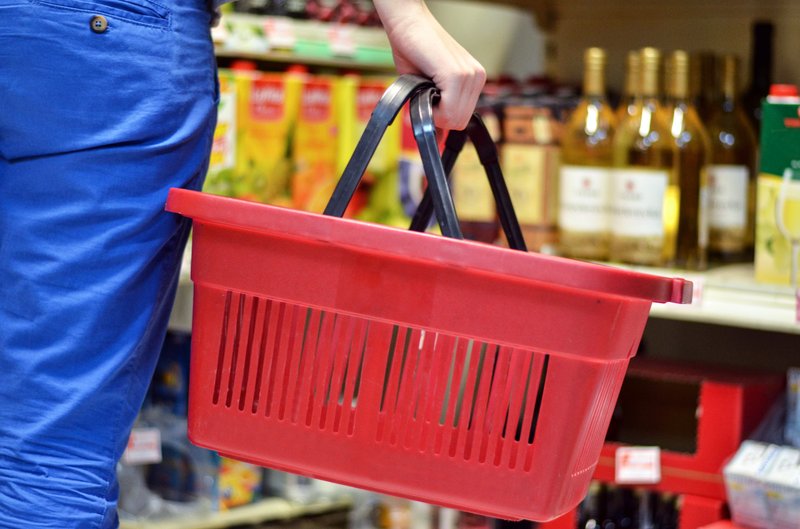Consumer price indices, May 2023
Prices up annually by 8.4%, monthly by 1.1%
In one year, prices were on average higher by 8.4%. Annual inflation was influenced the most by 14.7% higher prices of food. Monthly inflation was at 1.1%, mainly due to higher prices of tobacco (by 4.5%), package holidays (by 4.2%) and food (by 1.1%).
Annual inflation the lowest in the past 12 months
In May, annual inflation stood at 8.4% (in the same period last year it was 8.1%).
In one year, goods and service prices increased on average by 8.4% and 8.3%, respectively. Non-durable goods prices went up by 10.0%, semi-durable goods prices by 5.5%, and durable goods prices by 4.9%.
The biggest impact on the annual inflation, 2.3 percentage points, came from 14.7% higher prices of food. Among food items, sugar prices went up the most (by 45.9%). 0.8 p.p. was added by 7.7% higher prices of goods and services for recreation and culture. Electricity was more expensive by 24.0% and added 0.7 p.p. to inflation. Another 0.7 p.p. was added by 8.9% higher prices in the group furnishings, household equipment and routine household maintenance. 0.6 p.p. each was added by higher prices in the groups health (by 10.6%), restaurants and hotels (by 8.8%) and miscellaneous goods and services (7.8%).
On the other hand, cheaper liquid fuels (by 24.4%), diesel (by 14.6%) and petrol (by 10.2%) eased the annual inflation together by 0.9 p.p.
Monthly price growth at 1.1%
Compared to the previous month, consumer prices increased by 1.1%.
Monthly inflation was pushed up the most (by 0.2 p.p. each) by higher prices of tobacco (by 4.5%), package holidays (by 4.2%) and food (by 1.1%).
0.1 p.p. each was added by higher prices of heat energy (by 8.4%), refuse collection (by 5.2%), clothing (by 1.9%), catering services (by 1.1%) and health (by 0.9%).
In the last month, there were no notable price decreases.
Harmonised indices of consumer prices
Measured with the harmonised index of consumer prices, the annual growth of consumer prices was 8.1% (in May last year 8.7%). The monthly price growth was 0.9%.
On average, service prices went up by 8.2% and goods prices by 7.9%. Non-durable goods prices went up by 9.7%, semi-durable goods prices by 5.6% and durable goods prices by 3.5%.
Measured with the harmonised index of consumer prices, in April the annual inflation rate in the EMU countries was 7.0% (a month before 6.9%). In the EU-27 Member States it was 8.1% (a month before 8.3%). The lowest annual inflation rate was recorded in Luxemburg (2.7%) and the highest in Hungary (24.5%); in Slovenia it stood at 9.2%.
Table with the latest data is available in the SiStat Database.
In May, annual inflation stood at 8.4% (in the same period last year it was 8.1%).
In one year, goods and service prices increased on average by 8.4% and 8.3%, respectively. Non-durable goods prices went up by 10.0%, semi-durable goods prices by 5.5%, and durable goods prices by 4.9%.
The biggest impact on the annual inflation, 2.3 percentage points, came from 14.7% higher prices of food. Among food items, sugar prices went up the most (by 45.9%). 0.8 p.p. was added by 7.7% higher prices of goods and services for recreation and culture. Electricity was more expensive by 24.0% and added 0.7 p.p. to inflation. Another 0.7 p.p. was added by 8.9% higher prices in the group furnishings, household equipment and routine household maintenance. 0.6 p.p. each was added by higher prices in the groups health (by 10.6%), restaurants and hotels (by 8.8%) and miscellaneous goods and services (7.8%).
On the other hand, cheaper liquid fuels (by 24.4%), diesel (by 14.6%) and petrol (by 10.2%) eased the annual inflation together by 0.9 p.p.
Monthly price growth at 1.1%
Compared to the previous month, consumer prices increased by 1.1%.
Monthly inflation was pushed up the most (by 0.2 p.p. each) by higher prices of tobacco (by 4.5%), package holidays (by 4.2%) and food (by 1.1%).
0.1 p.p. each was added by higher prices of heat energy (by 8.4%), refuse collection (by 5.2%), clothing (by 1.9%), catering services (by 1.1%) and health (by 0.9%).
In the last month, there were no notable price decreases.
Harmonised indices of consumer prices
Measured with the harmonised index of consumer prices, the annual growth of consumer prices was 8.1% (in May last year 8.7%). The monthly price growth was 0.9%.
On average, service prices went up by 8.2% and goods prices by 7.9%. Non-durable goods prices went up by 9.7%, semi-durable goods prices by 5.6% and durable goods prices by 3.5%.
Measured with the harmonised index of consumer prices, in April the annual inflation rate in the EMU countries was 7.0% (a month before 6.9%). In the EU-27 Member States it was 8.1% (a month before 8.3%). The lowest annual inflation rate was recorded in Luxemburg (2.7%) and the highest in Hungary (24.5%); in Slovenia it stood at 9.2%.
Table with the latest data is available in the SiStat Database.
Annual growth rates of consumer prices, Slovenia
Growth rates of consumer prices, Slovenia
| |||||||||||||||||||||||||||||||||||||||||||||||||||||||||||||||||||||||||||||||||||||||||||||||||||||||||||
Harmonised indices of consumer prices, Slovenia
| |||||||||||||||||||||||||||||||||||||||||||||||||||||||||||||||||||||||||||||||||||||||||||||||||||||||||||
When making use of the data and information of the Statistical Office of the Republic of Slovenia, always add: "Source: SURS". More: Copyright.

.jpg)


